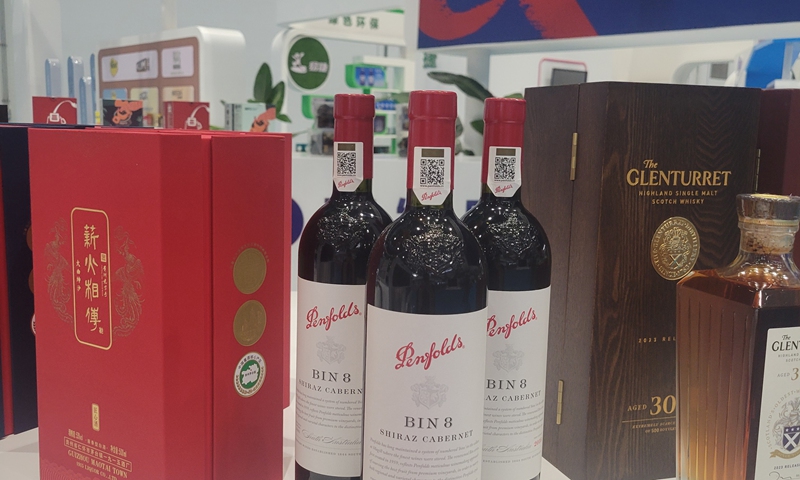
Australia-produced wine Bin 8 and St Henri on display at the ongoing 4th China International Consumer Products Expo on Saturday. Photo: GT
Australian wines Bin 8 and St Henri are on display at the ongoing 4th China International Consumer Products Expo in Haikou, South China's Hainan Province, making their debuts at a large-scale Chinese expo, after China's recent removal of anti-dumping and anti-subsidy tariffs on Australian wine.
Xiamen C&D International Wines & Spirits Group Co, the general agent of Australian wine company Treasury Wine Estates in China, featured the two products in the most conspicuous position of its booth at the exposition.
Yan Yizhen, a manager with the group, told the Global Times on Saturday that the appearance of Australian wine brands at the Hainan expo represents their comeback to the China market after China lifted tariffs on Australian wine.
"We are combing our dealership system and will recruit new dealers for the two brands. The wines are already at the warehouse of Treasury Wine Estates (TWE), waiting for a shipping date," Yan said. She said that TWE has made full preparations for a return to the China market, and shipments of wine are expected to arrive in China in May at the earliest.
More wine brands from Australia are expected to have a presence in the China market in the second half of 2024.
"We are going to organize an independent booth featuring Australian wine at the China International Import Expo [to be held in Shanghai in November]," a staff member from Top Select, an alcoholic beverage show event organizer, told the Global Times on Sunday.
China's Ministry of Commerce announced on March 28 that the country
would lift anti-dumping and anti-subsidy tariffs on Australian wine from March 29, triggering enthusiasm from Australian wine producers over once again tapping into the China market.
The tariffs were imposed on March 28, 2021 for a five-year period. Over the past three years, China's imports of wine products from Australia - which was previously one of the largest exporters of wine to China - immediately shrank, while countries such as France, Chile and Italy seized its market share.
"As the largest wine producer in Australia, TWE sells a large amount of wine to China every year. The two countries' trade friction over wine has had a heavy impact on the company. Over the past three years, TWE has struggled to find an alternative to the China market, but no market is as large as China," Yan said.
Yan said that the management of TWE closely follows the progress the two countries made in resolving wine trade disputes. Along with the overcoming of one and another obstacle, the signal is becoming clearer that it is time for Australian wine to return to China.
Following China's announcement of lifting the tariffs, Australian Prime Minister Anthony Albanese issued a joint statement with his trade and agriculture ministers, welcoming the decision. They said that it "comes at a critical time for the Australian wine industry" and both Australian producers and Chinese consumers will benefit from the reentry of Australian wine into the Chinese market.
Yan said that TWE plans to organize a series of activities this year, including press conferences and dealership dinners, in an attempt to regain its previous market standing in China.
Australian wine companies have advantages in returning to the China market, for example, shorter transport times compared with European wine and their better understanding of Chinese consumers. However, they also face challenges as China's wine market has experienced great changes over the past three years, according to Yan.
China's removal of tariffs on the Australian wine industry is favorable for Australian wine producers, which is a result of both sides' efforts, Chen Hong, president of the Chinese Association of Australian Studies and director of the Australian Studies Centre at East China Normal University, told the Global Times.
However, Australian wine companies have to make a greater effort to reenter the China market as other countries' wines now account for a significant market share, Chen noted.




